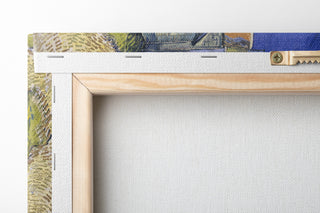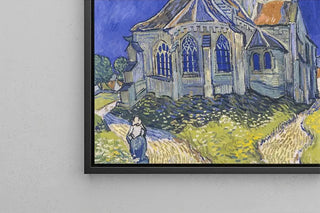Art print of L'homme à l'épée à double tranchant, Vision des sept candélabres - Ernst Ludwig Kirchner


View from behind

Frame (optional)
The dramatic tension of The Man with the Double-Edged Sword, Vision of the Seven Candlesticks by Ernst Ludwig Kirchner
The composition immediately sets a tense atmosphere: angular silhouettes, saturated colors, and sharp contrasts create an almost hallucinatory vision. Nervous strokes and the expressionist palette amplify the contained violence of the scene, while symbolic elements — the sword and the candlesticks — direct the gaze toward a mystical and dramatic interpretation. The showy touch of the artist gives the artwork an intense visual rhythm, between shadow and light, evoking emotion and questioning. This art print faithfully reproduces the chromatic impact and formal strength of the original.
Ernst Ludwig Kirchner, master of expressionism
A major painter and engraver of the early 20th century, Ernst Ludwig Kirchner was a central figure of the German Expressionist movement. Originating from the Die Brücke group, he explored expressive deformation of the body and space, influenced by primitive art, urban jazz, and the social upheavals of his time. His works, recognizable by their pictorial energy and angular compositions, profoundly influenced the avant-gardes and renewed the perception of artistic gesture. This art print pays tribute to his visual language and his ability to convey raw emotional intensity.
A decorative acquisition with multiple advantages
This art print of The Man with the Double-Edged Sword, Vision of the Seven Candlesticks is ideal for enriching a contemporary living room, a creatively inspired office, or a room with a strong character. The piece functions as a powerful focal point, bringing color, contrast, and visual storytelling to your decor. Created with a focus on chromatic fidelity and detail sharpness, the canvas of The Man with the Double-Edged Sword, Vision of the Seven Candlesticks offers a print quality that enhances the textures and nuances of the original. Adopt this canvas to introduce a piece of art history into your interior and invite aesthetic dialogue.

Matte finish

View from behind

Frame (optional)
The dramatic tension of The Man with the Double-Edged Sword, Vision of the Seven Candlesticks by Ernst Ludwig Kirchner
The composition immediately sets a tense atmosphere: angular silhouettes, saturated colors, and sharp contrasts create an almost hallucinatory vision. Nervous strokes and the expressionist palette amplify the contained violence of the scene, while symbolic elements — the sword and the candlesticks — direct the gaze toward a mystical and dramatic interpretation. The showy touch of the artist gives the artwork an intense visual rhythm, between shadow and light, evoking emotion and questioning. This art print faithfully reproduces the chromatic impact and formal strength of the original.
Ernst Ludwig Kirchner, master of expressionism
A major painter and engraver of the early 20th century, Ernst Ludwig Kirchner was a central figure of the German Expressionist movement. Originating from the Die Brücke group, he explored expressive deformation of the body and space, influenced by primitive art, urban jazz, and the social upheavals of his time. His works, recognizable by their pictorial energy and angular compositions, profoundly influenced the avant-gardes and renewed the perception of artistic gesture. This art print pays tribute to his visual language and his ability to convey raw emotional intensity.
A decorative acquisition with multiple advantages
This art print of The Man with the Double-Edged Sword, Vision of the Seven Candlesticks is ideal for enriching a contemporary living room, a creatively inspired office, or a room with a strong character. The piece functions as a powerful focal point, bringing color, contrast, and visual storytelling to your decor. Created with a focus on chromatic fidelity and detail sharpness, the canvas of The Man with the Double-Edged Sword, Vision of the Seven Candlesticks offers a print quality that enhances the textures and nuances of the original. Adopt this canvas to introduce a piece of art history into your interior and invite aesthetic dialogue.






